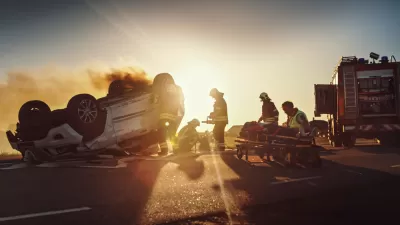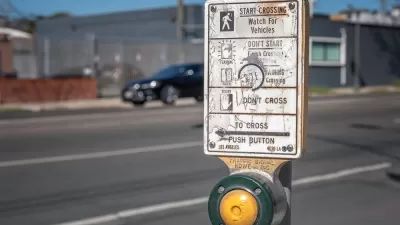Rates of traffic deaths vary widely among racial and economic groups but continue to rise across the board.

Although car crashes might seem like “an equal-opportunity public health problem,” David Leonhardt, writing in the New York Times, highlights the stark inequalities among economic and racial groups as traffic deaths rise sharply across the country.
Although traffic death rates were steadily declining since the 1970s, they started growing again in 2015, partly due to the ubiquity of smartphones and, consequently, distracted driving. “The U.S. has also been less aggressive about cracking down on speeding than Britain and some other parts of Europe, and vehicles here tend to be larger.” Since the pandemic began, road deaths rose even more dramatically.
As to the reasons for the inequity in traffic deaths, Leonhardt writes, “Poorer people are more likely to drive older cars, which can lack safety features. Low-income neighborhoods are also much more likely to have high-speed roads running through them.” And while some Americans were able to work from home during the pandemic, “many blue-collar Americans kept driving, biking or walking to work.”
Whatever the reasons for the growth in crashes, there are many known, simple solutions that safety advocates have touted for decades. As Leonhardt explains, “Those answers include: stricter enforcement of speed limits, seatbelt mandates and drunken-driving laws; better designed roads, especially in poorer neighborhoods; more public transit; and further spread of safety features like automated braking.”
FULL STORY: Race, Class and Traffic Deaths

Alabama: Trump Terminates Settlements for Black Communities Harmed By Raw Sewage
Trump deemed the landmark civil rights agreement “illegal DEI and environmental justice policy.”

Planetizen Federal Action Tracker
A weekly monitor of how Trump’s orders and actions are impacting planners and planning in America.

Why Should We Subsidize Public Transportation?
Many public transit agencies face financial stress due to rising costs, declining fare revenue, and declining subsidies. Transit advocates must provide a strong business case for increasing public transit funding.

Understanding Road Diets
An explainer from Momentum highlights the advantages of reducing vehicle lanes in favor of more bike, transit, and pedestrian infrastructure.

New California Law Regulates Warehouse Pollution
A new law tightens building and emissions regulations for large distribution warehouses to mitigate air pollution and traffic in surrounding communities.

Phoenix Announces Opening Date for Light Rail Extension
The South Central extension will connect South Phoenix to downtown and other major hubs starting on June 7.
Urban Design for Planners 1: Software Tools
This six-course series explores essential urban design concepts using open source software and equips planners with the tools they need to participate fully in the urban design process.
Planning for Universal Design
Learn the tools for implementing Universal Design in planning regulations.
Caltrans
Smith Gee Studio
Institute for Housing and Urban Development Studies (IHS)
City of Grandview
Harvard GSD Executive Education
Toledo-Lucas County Plan Commissions
Salt Lake City
NYU Wagner Graduate School of Public Service





























